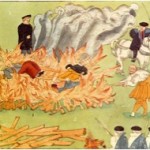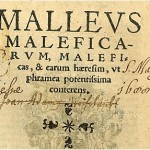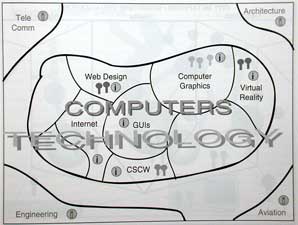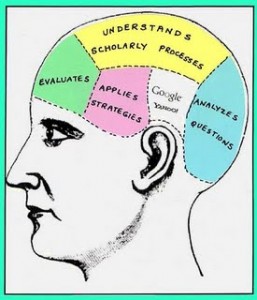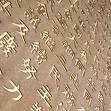Dear ETEC 540 colleagues,
- Please find our research paper in its entirety below. In keeping with our theme of radio in education, we have also decided to present our research in an abridged, primarily oral format on voicethread. You can listen to, view, and comment on this presentation by clicking the following link: http://voicethread.com/#q.b691487.i3656629
- In addition, we have also created delicious page to share our some of our resources with you. Please feel free to view or add any of the links at http://delicious.com/fvdeshoo/radio
Thank you, and we hope you enjoy reading, hearing and viewing our work!
Michael & Stephanie
________________________________________________________________________
On the air: Educational Radio, its history and effect on literacy, and educational technology implementation
Michael Haworth & Stephanie Hopkins
ETEC 540
October 26, 2009
“For it is the special glory of radio that it transcends boundaries, annihilates distance and creates a stronger sense of national unity and international brotherhood.” Canadian Broadcasting Corporation, 1941 (Nwaerondu, 1994, p. 2)
Educational radio: An introduction
At the dawn of the twentieth century, the development of what we now know as “radio” began. The work of scientists and inventors such as Nikola Tesla, Guglielmo Marconi, Lee De Forest, and many others laid the foundations for all forms of radio broadcasting (“History of Radio”, 2009). Starting in the early 1920’s, radio stations began transmitting to a relatively small, but growing number of listeners. Concomitant with the growing popularity of radio broadcasting was an increasing interest in its use in education. The reach and immediacy of radio provided educators with a new and potentially powerful medium through which to support and modify education. While firmly affixed in an oral and aural realm, from the outset, the purpose of educational radio has been to complement the existing curricula and strong reliance on written text within Western education systems of the twentieth century. Furthermore, educational radio set the stage for later educational technologies, providing a framework for the adoption and implementation of these technologies that has continued to date. In this introduction to and analysis of the history of educational radio, our purpose is three-fold: we hope to demonstrate how educational radio supported text-based education; describe how the inclusion of radio supported student literacy; and propose that the foundation of educational radio provided a framework for future efforts in the implementations of educational technology.
Prior to the development and wide-spread deployment of television, radio was the first electronic mass medium (Lewis, 1992, p. 26). Starting in 1920 in the United States, locations such as Detroit and Pittsburgh were initial launch points for radio broadcasting (Ackerman, 1945, p. 2). By 1922 there were thirty radio station transmitters and 60,000 receivers in use (Ackerman, 1945, p. 2). The number of radio transmitters and receivers in the United States continues to increase such that in 1942, Seerley Reid stated that “radio is an indispensable and indisputable part of American life” (p. 115). With its advent, the radio allowed anyone who had one to listen to news or other informational broadcasts without having to wait for the newspaper, or even listen to live entertainment without having to physically be there. Lewis (1992) described this profound change in dissemination of information by stating that, “the new medium of radio was to the printing press what the telephone had been to the letter: it allowed immediacy” (p. 26). From the time that the first sounds were broadcast over the U.S. airwaves in 1920, the two main functions of radio have been to entertain and to inform. As Ackerman (1945) noted, “no entertainment medium [had] ever before faced the insatiable demands which [were] laid upon radio” (p.10).
Radio in education: A brief historical overview
The use of radio as an educational tool further augmented its informational function. Programmes designed specifically for K-12 and post-secondary education were developed, both by private broadcasters and by radio stations set up exclusively for the use of education. Students, in traditional classroom settings (or individually via distance education) could listen to programs, or with the use of transceivers, could interact with radio programs. In this manner, students would receive educational programming that expanded on their classroom learning. Alternatively, not all educational efforts in radio were praised. According to Saettler (1990), “the first years of [American] university broadcasting were generally ineffective because many a professor repeated his classroom lecture before the microphone without realizing that a good lecturer was not necessarily an effective broadcaster” (as cited in Hokanson & Hooper, 2000, p. 542). The varying degrees to which the effectiveness of educational radio was perceived set the stage for discussion of future educational technologies and their effect on education.
In addition to targeting students, progressive educational radio could also focus on teachers, assisting them in “learn[ing] progressive Deweyan methods of teaching” (Cavanaugh, et al., 2004, p. 3). A good example of the imposition of education philosophy is in the distribution of radio teaching manuals at the Wisconsin School of the Air (Bianchi, 2002, p. 142). In these teaching manuals, ideas for strengthening and contextualizing radio programming in the classroom were suggested; such ideas were largely based on Dewey’s philosophy of experiential or activity-based learning (see Dewey, 1938). Teachers who created programs at the school agreed with the Deweyan philosophy and through programming, tried to demonstrate that when the classroom teacher actively facilitated learning, students were more attentive and involved (Bianchi, 2002, p.144). Thus, the new medium of radio was seen as aiding in the promotion and implementations of new, promising educational theories for teachers and students alike.
The implementation of educational radio in the U.S., Canada and Australia
Three locations in the world have had a strong background in implementing radio in education: the United States, Canada, and Australia. While other nations also developed educational radio programs, a brief examination of the implementation of and distinctions between radio implementation in these three countries highlights some of the major developments in the field, as development was not evenly distributed in the world or even within a country (Reid, 1942, p. 188).
Educational radio in the United States was provided both by educational institutions and by private, for-profit broadcasters. Starting in 1921, broadcasting licences were held by universities in Utah, Wisconsin, and Minnesota (Casey, 2008, p. 46). By 1925, 171 licences had been granted (Farley, 1952, p. 18). In addition, K-12 education systems in Ohio and Wisconsin were developing “schools of the air”, that would provide curriculum for use within traditional schools and distance education programs (Reid, 1942, p. 118; Williams & Nicholas, 2004, p. 111). In the case of the Wisconsin School of the Air, founders chose to offer programming that would complement the elementary curriculum, especially in rural areas where teachers were expected to teach many subjects in multi-grade classrooms (Bianchi, 2002). In this case, students were able to experience programming such as in music or other specialized field where the teacher may have little or no knowledge in that area.
In 1930, private broadcasters such as Columbia Broadcasting Systems (CBS) (“American School of the Air”), and the National Broadcasting Corporation (NBC) began developing educational radio programmes on a variety of music, science and social studies topics for use by students (Bagley, 1930, p. 256; Reid, 1942, p. 132-133). Again, these programmes met with a variety of success from being described as meeting, “in a fairly meritorious way the conditions that education broadcasting must meet if it is to be a useful adjunct to school instruction,” (Nasseh, 1997, para. 7) to a 1940 college-level course offered by radio that “failed to attract any enrollments” (Bagley, 1930, p. 257). Lewis (1992) suggests that private broadcasters may also have been encouraged to develop such programmes by lobby groups such as the “National Committee on Education by Radio” and “the threat of legislation,” by the United States Federal Communications Commission (FCC) (p. 31). As is the case with any major technological advancement, particularly in education, educational radio in the United States met with a collision between adversity and bewilderment; by so-called “technophobes” and “technophiles” (Postman, 1993).
Canada developed educational radio in a somewhat similar fashion to the United States, albeit on a smaller scale. Radio programmes were developed both for traditional classrooms and distance education. Starting in 1925, the Canadian National Railways (CNR) radio network broadcasted musical appreciation programmes (Buck, 2008, p. 80). The following year in 1926, CNRV, the CNR radio station in Vancouver broadcasted directly to Point Grey School for the Deaf and Blind (Buck, 2008, p. 80). The CNR radio network later was transformed into the Canadian Radio Broadcasting Commission, which ultimately became the Canadian Broadcasting Corporation (CBC). The CBC continued to provide educational radio programmes for provinces such as British Columbia (Buck, 2008, p. 8586), where other educational radio broadcasts took place through various provincial ministries of education via local radio stations. For example, CMHS in Nova Scotia provided government endorsed educational programming, while in Edmonton, Alberta, local station CKUA was the vehicle for educational radio (Buck, 2008, 86). Similarities and differences existed between the Canadian and American systems: in the United States, nation-wide broadcasting was lobbied for while in Canada, despite the similarity in the methodology of educational radio programme delivery, regional variances in educational radio demonstrate the diversity and locality of the Canadian education system.
Development of educational radio in Australia evolved in very different conditions. Due to low population densities in many areas of the country, K-12 students in remote locations either needed to attend boarding school, or work with postal-based correspondence school materials (Australian Government, 2007, para. 5). Through the support of the Royal Flying Doctors Service, shortwave radio broadcasts began to be delivered to outback students in 1948. By 1956, the “School of the Air” (SOTA) was developed and as of 2005, sixteen schools were in operation (Australian Government, 2007, para. 6-7). The SOTA program focused on student to teacher, teacher to student, and student to student radio communication rather than general scheduled programme broadcasting (Fowler, 1987, p. 119). The shortwave transceivers that students and teachers used allowed for synchronous, bi-directional communication so that both teachers and students could communicate directly with one another. Major benefits for students with this distinct approach are, “the feeling that the teacher is close at hand and the knowledge that he or she is being supported by the team approach of SOTA and PCS [Primary Correspondence School], and is [therefore] motivated by hearing the response of his or her peers, to perform well” (Fowler, 1987, p. 120). The differences between the Australian educational radio and the programs developed in the United States and Canada are described as being “distinctly Australian” (Moriarty, Danaher, & Danaher, 2003, p. 134), and as in the case of the North American ventures, various implications for education can be observed.
Making connections: Implications for education
While educational radio developed in different forms depending on the country and specific conditions, its primary goal was to complement and improve existing educational programs (Bagley, 1944, p.257). Although Thomas Edison predicted otherwise, radio programmes were not intended to supplant existing, text-based educational curriculum, but rather to, “supplement, or to stimulate, the study of subjects offered in schools” (Hinrichs, 2004, p. 6; Ackerman, 1945, p. 13). Educational theory of the day proposed that active engagement of students in materials, interactivity and engagement between teacher and students, as well as opportunities for more experiential learning would create a more solid, successful learning environment (see Dewey, 1938). By being offered in conjunction with traditional text-based curricula, educational radio made all of this possible.
This was especially true with the Australian School of the Air distance education programs. The Australian Government Culture Portal notes that in the SOTA program, “every student is provided with a mail delivered printed program with accompanying resources. This material is then supplemented by on-air lessons” (2007, para. 12). Students would work on printed curricula that would then be sent to the SOTA teacher for marking. Radio’s involvement in supporting and strengthening text could occur before, during, and after the writing process: teachers could provide direct lessons via radio on the written material, provide ongoing engagement and consultation with the student while working on the assignments, and finally, provide direct feedback on completed and evaluated work (Fowler, 1987, p. 120). This process provided a level of connectedness due to the synchronous communication afforded by radio that would not be possible with previous postal-only distance education programs, and allowed students to feel less isolated, and in turn, more engaged in their lessons. In addition, students and teachers were involved in an educational experience which included and valued orality as well as literacy, contributing to the overall literacy education of students. As Ong (2002) theorizes, the use of technologies such as radio in education lends itself well to the use of literacy theories such as speech-act and reader-response theory (p. 166-168). Moreover, much of the research on distance education programmes to date has shown that the use of multimedia technology in general has led to increased achievement among distance learners over classroom learners (see Williams, Nicholas & Gunter, 2004, p. 118). In Australia, the delivery of distance education, and thus the literacy education of students were significantly enhanced by the inclusion of radio in education.
The United States and Canadian educational radio systems differed significantly in overall design from the Australian version. These programs were meant primarily for unidirectional broadcasting of general programmes to a widely distributed learning audience within the traditional classroom setting. However, these programs too promoted text. The Ohio School of the Air suggested that the programs offered, “creative possibilities for English, speech, and dramatics teachers in developing students’ interest in radio writing and radio production” (Reid, 1942, p. 139). In 1932, Benjamin Darrow, founder and first director of the Ohio School of the Air stated his hope that, radio may come as a vibrant and challenging textbook of the air” (Hinrichs, 2004, p. 6). The reading and writing of text was supported by educational radio. Using radio promoted a new form of educational technology while introducing potentially new, progressive teaching methodologies into the classroom setting. As Boulter’s (2001) ideas about “remediation” suggest, the radio remediated print technology such that text technologies such as the newspaper became secondary to the radio in engaging and interacting with students. Teachers were able to draw on resources outside of the classroom in a new way with a sense of immediacy that would not be possible in pre-radio forms such as newspapers or films. In addition, with the distribution of teacher’s guides, programs such as the CBS American School of the Air were able to assist the teacher in using the provided programmes to their suggested best potential (Ackerman, 1945, p. 13), foreshadowing the lucrative teacher resource business that exists currently in education. Although the American and Canadian educational radio systems were different from the Australian one, these too had the potential to change educational practices and facilitate reading and writing.
Advantages and setbacks: Paving the way to the future
Cook and Nemzek (1939) stated that, “the invention of printing and textbooks did much to give to education in its present form. Some persons feel that the effects of radio may in time be equally far reaching” (p. 105). While there was a fervent wish for radio to become a strong player within education, this did not come entirely true. In North America, educational radio had several impediments to its widespread adoption in education systems. One of these impediments was the issue of availability of radio transmitters and receivers. During the “golden age of radio” a time that saw many homes equipped receivers, a limited numbers of schools were equally provisioned. In Ohio, a state in which schools were noted as “being more advanced in the use of radio than were schools through the country”, according to a 1941 survey, only fifty-five percent of Ohio schools were equipped with radio units (Reid, 1942, p. 119-121). Moreover, radio receivers of the time were of a fairly bulky size that limited portability and mobility; they were usually large console units which were required to house the heavy vacuum tubes and other necessary electronics. The onset of World War II created another obstacle in that the available number of vacuum tubes was diverted from civilian to military uses, thus reducing the number of new radio receivers and repair supplies for existing sets (Ackerman, 1945, p. 3). Another problem still was that radio reception quality could be mixed due to geography or distance for students in Australia and the United States (Fowler, 1987, p. 120; Reid, 1942, p. 123). Programme scheduling could also be an obstacle to adoption. Without the aid of any recording device, timing is vital in synchronous communications such as radio. All parties need to be transmitting and receiving at the same time, and all of the required communication components must successfully come together or communication does not happen. A final hindrance to the widespread adoption of radio in education is that teachers and students needed to be prepared to interact with the content of the radio programme. Planned curricular outcomes from radio programs needed to be considered, as “mere ‘listening-in’ may be a profitable expenditure of time in connection with an occasional program; but the more significant and more enduring benefits can come, if contemporary educational theory teaches us the truth, only when the learner is inspired to some effort on his own” (Bagley, 1930, p. 256). In order to reach widespread acceptance as a beneficial educational tool, it was imperative that radio be utilized and evaluated as such a tool, rather than the hasty, uninvolved use by what Postman calls “one-eyed prophets” (1993, p.5), or by educators who practiced traditional, non-engaging methodology in conjunction with its use in the classroom.
Although educational radio did not necessarily meet all of its intended aspirations to be as far reaching as textbooks, educational radio has survived in some forms. The School of the Air lives on in Australia and CKUA in Alberta continues to broadcast educational content, and networks such as the British Broadcasting Corporation (BBC) and the CBC still produce content that is suitable for classroom use, even if not specifically designed with such a purpose in mind. In the future, researchers might wish to explore this general interest in educational or documentary radio programming as related to the more recent technology of podcasting.
Educational radio also had the effect of foreshadowing future implementation of educational technology. It can be debated that the manner in which other technologies such as television and the Internet were incorporated in education because of the framework that was previously laid out by radio. Casey (2008) states that, “instructional radio paved the way for distance learning opportunities through television technology” (p. 46). Even further, Cavanaugh, et al. (2004) argues that based on the educational radio implementation model, “television, audio and video conferencing, the Internet, and other technologies have been adapted for the needs of young learners” (p. 3). Radio in education, a pioneer of educational technology, created a legacy for itself by setting the stage for the development of other technologies still used in education to date, and perhaps will continue with other technologies in the future. As Lewis (1992) notes, “radio still captures the imagination, too. As a child once said, he preferred radio over television because ‘the pictures are better’” (p.32).
References
Ackerman, W. C. (1945). The dimensions of American broadcasting. The Public Opinion Quarterly, 9(1), 1-18.
Australian Government. (n.d.). The School of the Air and remote learning. Australia’s Culture Portal. Retrieved October 17, 2009 from http://www.cultureandrecreation.gov.au/articles/schoolofair/.
Bagley, W. C. (1930). Radio in the Schools. The Elementary School Journal, 31(4), 256-258. doi: 10.2307/996158.
Bianchi, W. (2002). The Wisconsin School of the Air: Success story with implications. Educational Technology and Society 5(1), 141-147.
Bolter, J. D. (2001). Writing space: Computers, hypertext, and the remediation of print (2nd ed.). Mahwah, NJ: Lawrence Erlbaum Associates.
Buck, G. H. (2006). The first wave: The beginnings of radio in Canadian distance education. Journal of Distance Education, 21(1), 76.
Casey, D. M. (2008). A Journey to Legitimacy: The Historical Development of Distance Education through Technology. TechTrends, 52(2), 45-51. doi: 10.1007/s11528-008-0135-z.
Cavanaugh, C., Gillan, K. J., Kromrey, J., Hess, M., & Blomeyer, R. (2004). The effects of distance education on K–12 student outcomes: A meta-analysis. Naperville, IL: Learning Point Associates.
Cook, D. C., & Nemzek, C. L. (1939). The Effectiveness of Teaching by Radio. The Journal of Educational Research, 33(2), 105-109. doi: 10.2307/27526643.
Dewey, J. (1938). Experience and education. Indianapolis: Kappa Delta Pi. Preview retrieved from http://books.google.ca/books?id=UE2EusaU53IC&dq=%22Dewey%22+%22Experience+and+education%22+&lr=&source=gbs_navlinks_s.
Farley, B. (1952). Education and Television. Music Educators Journal, 39(2), 18-20. doi: 10.2307/3388644.
Fowler, B. (1987). Aussat and all that! Reaching the Australian outback. Australian Journal of Educational Technology, 3(2), 119-128.
Hokanson, B & Hooper, S. (2000). Computers as cognitive media: Examining the potential of computers in education. Computers in Human Behavior 16, 537-552.
Hinrichs, R. (2004). A vision for lifelong learning: year 2020. European Journal of Engineering Education, 29(1), 5-16.
History of Radio. (2009, October 21). In Wikipedia, the free encylcopedia. Retrieved October 23, 2009 from http://en.wikipedia.org/wiki/History_of_radio.
Lewis, T. (1992). “A Godlike presence”: The impact of radio on the 1920s and 1930s. Magazine of History, 6(4), 26-33. doi: 10.2307/25154082.
Moriarty, B. J., Danaher, P. A., & Danaher, G. R. (2003). Situating and interrogating contemporary Australian rural education research. Journal of Research in Rural Education, 18(3), 133-138.
Nasseh, B. (1999). A brief history of distance education. Adult Education in the News, available at: www. seniornet. org/edu/art/history. html (accessed 2 October 2004).
Nwaerondu, N. G. (1994). Educational radio: A tool for rural change. Retrieved October 17, 2009, from http://www.eric.ed.gov/ERICWebPortal/contentdelivery/servlet/ERICServlet?accno=ED390624.
Ong, W.J. (2002). Orality and Literacy (2nd ed.). New York: Routledge.
Postman, N. (1993). The judgment of Thamus. Technopoly: The Surrender of Culture to Technology. New York: Vintage.
Reid, S. (1942). Radio in the Schools of Ohio. Educational Research Bulletin, 21(5), 115-148. doi: 10.2307/1473784.
Stevens, K. (1994). Australian developments in distance education and their implications for rural schools. Journal of Research in Rural Education, 10(1), 78-83.
Williams, P., Nicholas, D., & Gunter, B. (2005). E-learning: What the literature tells us about distance education. Perspectives, 57(2), 109-122.

